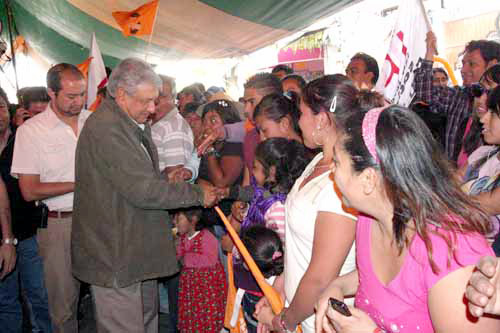
On July 3, voters in the central State of Mexico, in Mexico, will elect a new governor, to succeed Enrique Peña Nieto of the Revolutionary Institutional Party (PRI). More is at stake than one governorship out of 31 in this country of 108 million people. The future of the main left-center electoral party, the PRD (Revolutionary Democratic Party) also hangs in the balance.
Mexico is the largest Mexican state, with more than 15 million inhabitants. It includes much of the old Aztec Empire, and surrounds Mexico City on the North, East and West. It contains huge Mexico City suburbs, including Ciudad Nezahualcoyotl, Ecatepec, Texcoco, and the state capital Toluca. It has a high concentration of industry, and thus a very large working class.
The left-center PRD was formed in 1989, with a coming together of left wing dissidents from the PRI, former members of the old Communist Party of Mexico (PCM) and others. During the 1988 presidential elections, most of the left supported the candidacy of Cuautehmoc Cardenas Solorzano, the son of Mexico’s revered former president (1934-1940), Lazaro Cardenas del Rio. Cardenas won, but the election was stolen and the PRI candidate, Carlos Salinas de Gortari, was imposed. Cardenas’ supporters decided to merge several existing parties into the new PRD structure.
But the combination of former communists with former “priistas” has been fractious, and there has been a lot of opportunism within the PRD. In the 2000 presidential election, two major PRD leaders, Porfirio Muñoz Ledo (former leader of the PRI) and Jorge Casteñeda (former communist), ditched the PRD’s presidential candidate and supported Vicente Fox of the right-wing National Action Party (PAN). They said they wanted to back the candidate most likely to end the PRI’s 70 year stranglehold on power. But Fox took Mexico even further in the direction of free market, neo liberal policies than had his PRI predecessors.
In the 2006 presidential elections, the candidate of the PRD and allies was former Mexico City region governor Andres Manuel Lopez Obrador (“AMLO”). He won the Mexico City area easily, but PAN candidate Felipe Calderon was declared president. AMLO and his supporters claimed fraud and refused to recognize Calderon, but also complained that some regional PRD leaders did not lift a finger to help.
Since then, fierce internal fights have harmed the PRD’s prestige.
Now Mexico’s 2012 presidential elections loom.
The country is in bad shape, hit especially hard by the world financial and economic crisis of 2008 which led to a 6.8% drop of the Gross Domestic Product. Wars between drug gangs have undermined people’s sense of security, and food prices are rising sharply. Things are looking bad for the PAN, on whose watch these disasters have happened.
The PRI is grooming outgoing governor Peña Nieto of the State of Mexico as its candidate. He may be movie-star handsome and articulate but he has been accused of vicious violations of citizens rights. In any case the PRI may well sweep back into power in 2012.
The right wing leaders currently dominant in the PRD propose joint candidacies with the PAN, explaining that they want to prevent, at all costs, a PRI comeback. They tried this in state elections last year, with poor results, but they still want to have another go at it in the gubernatorial election in the State of Mexico.
The left wing of the PRD, including AMLO, is against this on principle. The PAN for them epitomizes a reactionary trend, which has favored foreign corporations and hurt Mexican farmers and workers. The PRD left has promised to try to repair some of the damage that neo-liberal policies of privatization, austerity and union-busting have done. AMLO has formed a coalition with two smaller leftist parties with congressional representation rather than cozying up to the PAN.
Veteran leftist Alejandro Encinas has made clear that he will run for governor, and that he opposes an unprincipled pact with the PAN. But the state organization of the PRD is going ahead with conversations with PAN leaders for such a pact and is setting up a “consultation” with the PRD base to get support.
AMLO has been touring Mexico State to promote Encinas and to oppose the idea of a PRD-PAN bloc. He is obviously seen by the PRD left as their best prospect as a 2012 presidential candidate. His book on the future of Mexico, La Mafia que se Adueño de Mexico, y el 2012 (“The Mafia Which Took Over Mexico, and [the election of] 2012”) has won the praise of former Cuban President Fidel Castro and also of the People’s Socialist Party of Mexico, a Marxist party which up to now had stayed at arm’s length from the PRD.
AMLO will also probably have the support of independent unions and farmers organizations. Whether this can outweigh the opportunistic currents in his own party, not to mention the massive support of the Mexican ruling class and international monopoly capital for both the PRI and the PAN, is yet to be seen.
Photo: Andres Manuel Lopez Obrador (“AMLO”) meeting with supporters.

MOST POPULAR TODAY


Zionist organizations leading campaign to stop ceasefire resolutions in D.C. area

High Court essentially bans demonstrations, freedom of assembly in Deep South

Afghanistan’s socialist years: The promising future killed off by U.S. imperialism

Communist Karol Cariola elected president of Chile’s legislature






Comments